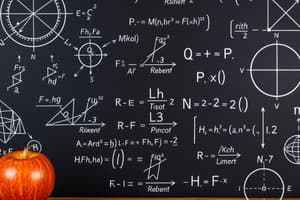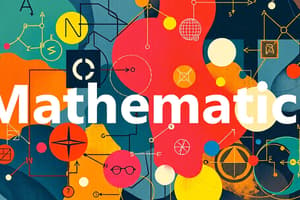Podcast
Questions and Answers
Which branch of mathematics focuses on the study of shapes and their properties?
Which branch of mathematics focuses on the study of shapes and their properties?
- Algebra
- Statistics
- Geometry (correct)
- Trigonometry
What type of equation involves variables raised to the second power?
What type of equation involves variables raised to the second power?
- Polynomial equations
- Quadratic equations (correct)
- Linear equations
- Exponential equations
Which theorem states that in a right triangle, the sum of the squares of the two shorter sides equals the square of the longest side?
Which theorem states that in a right triangle, the sum of the squares of the two shorter sides equals the square of the longest side?
- Binomial Theorem
- Fundamental Theorem of Algebra
- Central Limit Theorem
- Pythagorean Theorem (correct)
Which branch of mathematics examines the collection and interpretation of data?
Which branch of mathematics examines the collection and interpretation of data?
What does the Fundamental Theorem of Algebra state about polynomial equations?
What does the Fundamental Theorem of Algebra state about polynomial equations?
Which mathematical operation is used to combine numbers to find a total?
Which mathematical operation is used to combine numbers to find a total?
In what type of function does each input correspond to a unique output?
In what type of function does each input correspond to a unique output?
What relationship does Trigonometry primarily study?
What relationship does Trigonometry primarily study?
Flashcards are hidden until you start studying
Study Notes
Overview of Mathematics
- Definition: The study of numbers, quantities, shapes, and patterns.
- Branches:
- Arithmetic: Basic operations (addition, subtraction, multiplication, division).
- Algebra: Study of symbols and rules for manipulating those symbols.
- Geometry: Study of shapes, sizes, and properties of space.
- Trigonometry: Study of relationships between angles and sides of triangles.
- Calculus: Study of change and motion; involves derivatives and integrals.
- Statistics: Study of data collection, analysis, interpretation, and presentation.
- Probability: Study of chance and uncertainty.
Key Concepts
- Numbers:
- Types: Whole numbers, integers, rational numbers, irrational numbers, real numbers, complex numbers.
- Equations:
- Linear equations: Involves variables raised to the first power.
- Quadratic equations: Involves variables raised to the second power.
- Functions:
- Definition: A relation where each input has a single output.
- Types: Linear, quadratic, polynomial, exponential, logarithmic.
Mathematical Operations
- Basic Operations:
- Addition (+)
- Subtraction (−)
- Multiplication (×)
- Division (÷)
Theorems and Principles
- Pythagorean Theorem: In a right triangle, a² + b² = c².
- Fundamental Theorem of Algebra: Every non-constant polynomial equation has at least one complex root.
- Central Limit Theorem: The distribution of sample means approaches a normal distribution as the sample size increases.
Applications of Mathematics
- Real-world Applications:
- Engineering: Design and optimization.
- Physics: Motion, forces, energy calculations.
- Economics: Modeling financial systems and trends.
- Computer Science: Algorithms, data structures, cryptography.
Mathematical Notation
- Use of symbols and notation to represent mathematical ideas succinctly.
- Common symbols:
- ∑ (summation)
- ∏ (product)
- ∫ (integral)
- ∆ (change/difference)
Study Tips
- Practice regularly to strengthen problem-solving skills.
- Understand concepts rather than memorizing procedures.
- Utilize visual aids like graphs and diagrams for geometric and algebraic concepts.
- Work on diverse problems to apply learned concepts in various contexts.
Overview of Mathematics
- Mathematics encompasses the study of numbers, quantities, shapes, and patterns.
- Major branches include:
- Arithmetic: Involves basic operations such as addition, subtraction, multiplication, and division.
- Algebra: Focuses on symbols and rules for manipulating these symbols.
- Geometry: Examines shapes, sizes, and spatial properties.
- Trigonometry: Analyzes relationships between angles and sides in triangles.
- Calculus: Investigates change and motion through derivatives and integrals.
- Statistics: Concerned with data collection, analysis, interpretation, and presentation.
- Probability: Deals with the study of chance and uncertainty.
Key Concepts
- Numbers can be categorized into various types:
- Whole numbers, integers, rational numbers, irrational numbers, real numbers, and complex numbers.
- Equations types include:
- Linear equations with variables to the first power.
- Quadratic equations with variables to the second power.
- Functions are defined as relations where each input corresponds to a single output, including types like linear, quadratic, polynomial, exponential, and logarithmic.
Mathematical Operations
- Basic operations crucial for mathematics include:
- Addition (+)
- Subtraction (−)
- Multiplication (×)
- Division (÷)
Theorems and Principles
- Pythagorean Theorem: States that for a right triangle, the relation a² + b² = c² holds.
- Fundamental Theorem of Algebra: Asserts that every non-constant polynomial equation has at least one complex root.
- Central Limit Theorem: Indicates that as the sample size increases, the distribution of sample means approaches a normal distribution.
Applications of Mathematics
- Mathematics has practical applications in various fields:
- Engineering: Used for design and optimization processes.
- Physics: Essential for computations involving motion, forces, and energy.
- Economics: Provides models for analyzing financial systems and trends.
- Computer Science: Integral for algorithms, data structures, and cryptography.
Mathematical Notation
- Mathematical notation uses symbols and concise representations of ideas.
- Common symbols include:
- ∑ (summation)
- ∏ (product)
- ∫ (integral)
- ∆ (change/difference)
Study Tips
- Regular practice is key to enhancing problem-solving abilities.
- Aim to grasp concepts fully instead of rote memorization of procedures.
- Utilize visual aids such as graphs and diagrams to clarify geometric and algebraic ideas.
- Tackle a variety of problems to effectively apply learned concepts across different situations.
Studying That Suits You
Use AI to generate personalized quizzes and flashcards to suit your learning preferences.




